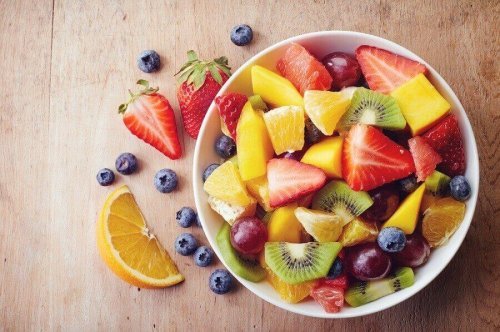What Are the Nutritional Needs of Adolescents?

When children start entering adolescence, parents may begin to have several concerns. One of the most common ones is: What are the nutritional needs of adolescents?
A good diet is key when it comes to properly facing all the physiological changes that occur during this stage. There are important nutritional needs of adolescents that we should be aware of.
When puberty begins, changes occur in order to reach a person’s sexual maturity. Each gender experiences changes at different ages. Generally, girls begin their development from the ages of 8 to 11, and boys from 10 to 14 years of age.
Nutritional needs of adolescents
Proper nutrition is fundamental to face the changes that occur in adolescence. An ideal diet that can meet the nutritional needs of teenagers should contain the following:
Calories
Calories are the energy units that are contained in food. Adolescents who practice physical activities need significant amounts of food with caloric content. When kids are in this stage, they usually do more activities and, therefore, consume many more calories.
In some cases, adolescents tend to be more sedentary and parents must watch their diet more closely, in caloric terms, to avoid obesity. At the end of adolescence, girls tend to eat fewer calories a day than boys. As a result, they may experience a deficiency in certain minerals and vitamins.
Proteins
50% of our body weight is made up of proteins. The foods that contain more protein are: beef, chicken, turkey, pork, fish, eggs, and cheese.
For full development, teenagers shouldn’t lack proteins. They won’t only help them feel satisfied when eating, but also contribute to the strengthening of body mass and the functioning of the body’s organs.
For an adolescent athlete, optimal performance will always depend on muscular strength. This can be obtained with a balanced diet rich in proteins.
Carbohydrates
We find them in starches, sugars, and they become the main fuel in our bodies, which is a simple sugar: glucose. A teenager’s diet should include foods with complex carbohydrates and limit the simple ones.
Complex carbohydrates provide continuous energy, which is why athletes consume them in large quantities; while simple carbs offer few benefits, which is why they should be reduced.

Fats
It’s advisable for adolescents to avoid consuming more than 30% of fats in their diet. They provide energy and absorb vitamins A, D, E, and K. Consuming more than 30% fat can lead to weight gain.
Fatty foods contain cholesterol, which is a waxy substance that clogs arteries and hardens them. There are 3 types of fats in a teenager’s common diet:
- Monounsaturated: the healthiest. They include olives, olive oil, peanuts, peanut butter, walnuts, and walnut and canola oils.
- Polyunsaturated: we can find them in corn, sunflowers, soybeans, cottonseeds, and sesame seed oils.
- Saturated: the most laden with cholesterol. They’re found in dairy products like butter, cheese, beef, pork, lamb, egg yolks, coconut oil, and palm oil.
It’s recommended to reduce the intake of saturated fat to no more than 10% of the total daily calories. The other 20% of calories should come from two types of unsaturated fats.
Minerals
There are three minerals that have special importance: calcium, iron, and zinc. They’re directly related to growth. Thus, the diet should contain foods rich in these types of minerals: milk, clams, red meat, nuts, chocolate, sesame seeds, lamb, oysters, among others.

Vitamins
To meet the nutritional needs of adolescents, the consumption of vitamins shouldn’t be left to chance. Vitamin A intervenes in the processes of cell growth, differentiation, proliferation, and reproduction. Vitamin D is necessary for the process of bone calcification.
Vitamins B12, B6, riboflavin, niacin, and thiamine are involved in energy metabolism. They participate in the metabolism of amino acids and in the maturation of erythrocytes.
Taking into account all this nutritional data will make it easier to provide a balanced diet and help prevent possible issues.
Remember that by setting the example and accompanying them, our children will learn to maintain good eating habits at different stages of their development. A healthy life translates into multiple benefits, so it’s worth investing effort in it.
When children start entering adolescence, parents may begin to have several concerns. One of the most common ones is: What are the nutritional needs of adolescents?
A good diet is key when it comes to properly facing all the physiological changes that occur during this stage. There are important nutritional needs of adolescents that we should be aware of.
When puberty begins, changes occur in order to reach a person’s sexual maturity. Each gender experiences changes at different ages. Generally, girls begin their development from the ages of 8 to 11, and boys from 10 to 14 years of age.
Nutritional needs of adolescents
Proper nutrition is fundamental to face the changes that occur in adolescence. An ideal diet that can meet the nutritional needs of teenagers should contain the following:
Calories
Calories are the energy units that are contained in food. Adolescents who practice physical activities need significant amounts of food with caloric content. When kids are in this stage, they usually do more activities and, therefore, consume many more calories.
In some cases, adolescents tend to be more sedentary and parents must watch their diet more closely, in caloric terms, to avoid obesity. At the end of adolescence, girls tend to eat fewer calories a day than boys. As a result, they may experience a deficiency in certain minerals and vitamins.
Proteins
50% of our body weight is made up of proteins. The foods that contain more protein are: beef, chicken, turkey, pork, fish, eggs, and cheese.
For full development, teenagers shouldn’t lack proteins. They won’t only help them feel satisfied when eating, but also contribute to the strengthening of body mass and the functioning of the body’s organs.
For an adolescent athlete, optimal performance will always depend on muscular strength. This can be obtained with a balanced diet rich in proteins.
Carbohydrates
We find them in starches, sugars, and they become the main fuel in our bodies, which is a simple sugar: glucose. A teenager’s diet should include foods with complex carbohydrates and limit the simple ones.
Complex carbohydrates provide continuous energy, which is why athletes consume them in large quantities; while simple carbs offer few benefits, which is why they should be reduced.

Fats
It’s advisable for adolescents to avoid consuming more than 30% of fats in their diet. They provide energy and absorb vitamins A, D, E, and K. Consuming more than 30% fat can lead to weight gain.
Fatty foods contain cholesterol, which is a waxy substance that clogs arteries and hardens them. There are 3 types of fats in a teenager’s common diet:
- Monounsaturated: the healthiest. They include olives, olive oil, peanuts, peanut butter, walnuts, and walnut and canola oils.
- Polyunsaturated: we can find them in corn, sunflowers, soybeans, cottonseeds, and sesame seed oils.
- Saturated: the most laden with cholesterol. They’re found in dairy products like butter, cheese, beef, pork, lamb, egg yolks, coconut oil, and palm oil.
It’s recommended to reduce the intake of saturated fat to no more than 10% of the total daily calories. The other 20% of calories should come from two types of unsaturated fats.
Minerals
There are three minerals that have special importance: calcium, iron, and zinc. They’re directly related to growth. Thus, the diet should contain foods rich in these types of minerals: milk, clams, red meat, nuts, chocolate, sesame seeds, lamb, oysters, among others.

Vitamins
To meet the nutritional needs of adolescents, the consumption of vitamins shouldn’t be left to chance. Vitamin A intervenes in the processes of cell growth, differentiation, proliferation, and reproduction. Vitamin D is necessary for the process of bone calcification.
Vitamins B12, B6, riboflavin, niacin, and thiamine are involved in energy metabolism. They participate in the metabolism of amino acids and in the maturation of erythrocytes.
Taking into account all this nutritional data will make it easier to provide a balanced diet and help prevent possible issues.
Remember that by setting the example and accompanying them, our children will learn to maintain good eating habits at different stages of their development. A healthy life translates into multiple benefits, so it’s worth investing effort in it.
All cited sources were thoroughly reviewed by our team to ensure their quality, reliability, currency, and validity. The bibliography of this article was considered reliable and of academic or scientific accuracy.
- McHill, N. Teen nutrition: making healthy food choices easily. The Nation’s Health January 2016, 45 (10) 36. [Online] Avaiable at: http://thenationshealth.aphapublications.org/content/45/10/36
- Johnson, Fiona & Wardle, J & Griffith, J. (2002). The Adolescent Food Habits Checklist: reliability and validity of a measure of healthy eating behaviour in adolescents. European journal of clinical nutrition. 56. 644-9. 10.1038/sj.ejcn.1601371.
- Julyana Gall da Silva, Maria Luiza de Oliveira Teixeira, Márcia de Assunção Ferreira. Eating during adolescence and its relations with adolescent health. Text Context Nursing, Florianópolis, 2014 Oct-Dec; 23 (4): 1095-103. [Online] Avaiable at: http://www.scielo.br/pdf/tce/v23n4/0104-0707-tce-23-04-01095.pdf
This text is provided for informational purposes only and does not replace consultation with a professional. If in doubt, consult your specialist.








